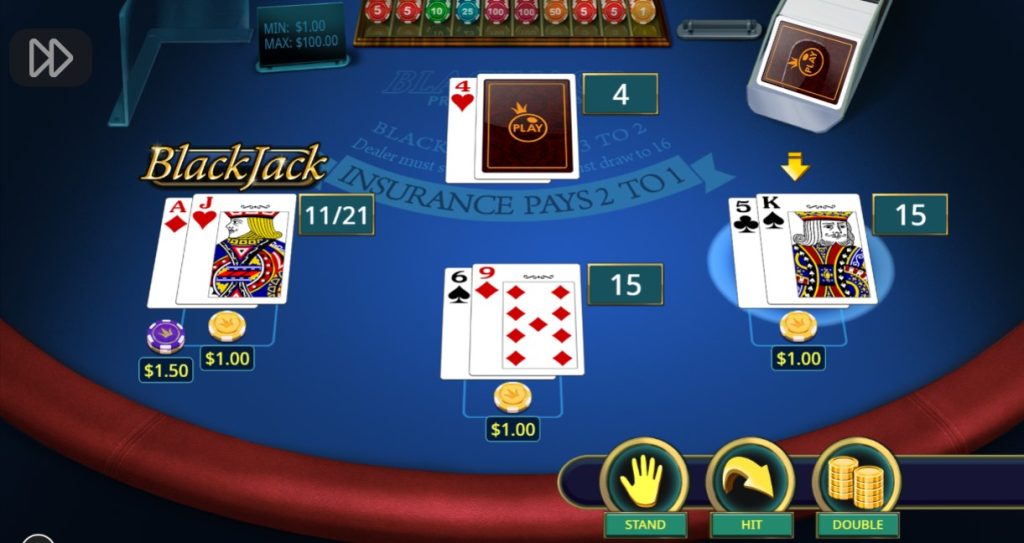For players seeking more action and faster gameplay, Multi-hand Blackjack offers an exciting twist. As the name suggests, this variant allows you to play multiple hands simultaneously against the dealer in a single round (just like in our free Blackjack simulator), amplifying the intensity and betting opportunities. While it might seem complex, Multi-hand Blackjack largely follows the standard rules, just applied across several hands at once.
Understanding the Rules
The core objective remains the same as classic blackjack: beat the dealer’s hand by getting a total closer to 21 without exceeding it (busting). Here’s how it typically works:
- The Setup: The game is played with one or more standard 52-card decks, often consolidated into a “shoe” containing 6 to 8 decks. Card values are standard: cards 2 through 10 hold their face value, face cards (Jack, Queen, King) are worth 10 points, and Aces can be valued as either 1 or 11, whichever benefits the hand most.
- Gameplay Flow:
- Betting: Before cards are dealt, you place bets on each hand you wish to play. Depending on the specific table (online or land-based), you might play anywhere from two to five hands concurrently.
- Dealing: Each active hand you’ve bet on receives two cards, dealt face-up. The dealer also receives two cards: one face-up (the upcard) and one face-down (the hole card).
- Player’s Turn: You play each of your hands sequentially, one after the other, before the dealer plays their hand. For each hand, you must decide:
- Hit: Take an additional card.
- Stand: Keep your current hand total and take no more cards.
- Double Down: Double your initial bet on that hand, receive exactly one more card, and then stand. This is typically allowed only on your first two cards.
- Split: If your first two cards form a pair (e.g., two 8s or two Kings), you can split them into two separate hands. You must place an additional bet equal to your original wager on the new hand. Rules for hitting split hands (especially Aces, which often get only one card each) can vary.
- Surrender (if offered): Some tables allow you to forfeit your hand and half your bet before playing it further (usually only possible right after the deal).
- Dealer’s Turn: Once you have played all your hands (either standing or busting), the dealer reveals their hole card. The dealer must hit until their hand total reaches at least 17. Some casinos require the dealer to hit on a “soft 17” (an Ace counted as 11), while others require them to stand. If the dealer’s total exceeds 21, they bust.
- Outcomes for Each Hand: Each of your hands is resolved independently against the dealer’s final hand:
- Win: Your hand total is closer to 21 than the dealer’s, or the dealer busts. Pays 1:1.
- Blackjack: You are dealt an Ace and a 10-value card on your first two cards (a natural 21). This typically pays 3:2, though some tables offer a less favorable 6:5 payout. A player Blackjack beats any dealer hand except a dealer Blackjack.
- Push: Your hand total ties with the dealer’s (and neither busted). Your bet for that hand is returned.
- Loss: Your hand busts (goes over 21), or the dealer’s hand is closer to 21 than yours without busting. You lose your bet for that hand.
- Multi-Hand Specifics: Remember, you could win on some of your hands and lose or push on others in the same round. The crucial element is that all your active hands play against the same dealer hand.
- Important Rule Variations: Always check the specific table rules before playing, as they significantly impact strategy and odds. Key variations include:
- Number of decks used.
- Whether the dealer hits or stands on Soft 17.
- Restrictions on doubling down (e.g., only on certain totals, allowed after splitting?).
- Restrictions on splitting (e.g., how many times can you re-split pairs? Can you hit split Aces?).
- Blackjack payout (3:2 is standard; avoid 6:5 if possible).
- Availability of side bets (like Perfect Pairs or 21+3).
Multi-Hand Blackjack Strategy

While playing multiple hands increases the action, it doesn’t inherently change the optimal way to play each individual hand.
- Play Each Hand Independently: This is the most critical strategic principle. Treat each hand as a separate encounter against the dealer’s upcard. The decision you make on one hand should not influence the mathematically correct decision for another hand, unless basic strategy dictates the same action based on that specific hand’s total and the dealer’s upcard.
- Basic Strategy Reigns Supreme: The optimal strategy for Multi-hand Blackjack is the same as for single-hand blackjack: use basic strategy. The house edge on any single hand doesn’t change just because you’re playing more hands. Ensure you are using a basic strategy chart that matches the specific rules of your table (number of decks, dealer hits/stands on soft 17, etc.).
- Bankroll and Risk Management: Playing multiple hands means wagering more money per round. This increases your potential exposure and variance – you can experience bigger wins but also bigger losses more quickly. It’s essential to adjust your bet size per hand to stay within your bankroll limits. If you normally bet $10 per hand, playing three hands means you’re risking $30 per round.
- Pros and Cons:
- Pros: More action per hour; potentially faster accumulation of loyalty points/comps; useful for card counters to increase their bet spread when the count is favorable.
- Cons: Significantly higher variance; requires a larger bankroll to weather swings; does not lower the house edge; increases your theoretical hourly loss (as you’re making more wagers against the house edge over time).
- Considerations for Advantage Players (Card Counters): For card counters, playing multiple hands is a key tool. When the deck is rich in high cards (a positive count), spreading to multiple hands allows them to get more money on the table while they have the advantage. Conversely, playing multiple hands in a negative count can help “chew through” the low cards faster, potentially accelerating the return to a neutral or positive count.
- Common Myths Debunked:
- Myth: Playing more hands increases your overall chance of winning. Fact: The house edge applies to each hand independently. Playing more hands increases your total wager and variance, not your fundamental odds per hand.
- Myth: You should try to make similar decisions across your hands (e.g., stand on all if one looks strong). Fact: Play each hand according to basic strategy based only on that hand’s cards and the dealer’s upcard.
Final Tips
- Know the Rules: Before betting, confirm the specific table rules (Soft 17, Double/Split rules, BJ payout).
- Use the Right Chart: Employ a basic strategy chart tailored to those specific rules.
- Manage Your Money: Adjust your bet size per hand to accommodate the higher risk and variance of playing multiple spots.
- Play Independently: Make the optimal basic strategy decision for each hand, regardless of your other hands.
Multi-hand Blackjack offers a dynamic way to enjoy blackjack, providing more betting action per round. By understanding the rules, applying basic strategy diligently to each hand, and managing your bankroll wisely, you can navigate this exciting variant effectively.



